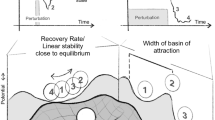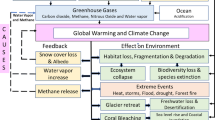Abstract
The impact of climate change on mountain ecosystems has been in the spotlight for the past three decades. Climate change is generally considered to be a threat to ecosystem health in mountain regions. Vegetation indices can be used to detect shifts in ecosystem phenology and climate change in mountain regions while satellite imagery can play an important role in this process. However, what has remained problematic is determining the extent to which ecosystem phenology is affected by climate change under increasingly warming conditions. In this paper, we use climate and vegetation indices that were derived from satellite data to investigate the link between ecosystem phenology and climate change in the Namahadi Catchment Area of the Drakensberg Mountain Region of South Africa. The time series for climate indices as well as those for gridded precipitation and temperature data were analyzed in order to determine climate shifts, and concomitant changes in vegetation health were assessed in the resultant epochs using vegetation indices. The results indicate that vegetation indices should only be used to assess trends in climate change under relatively pristine conditions, where human influence is limited. This knowledge is important for designing climate change monitoring strategies that are based on ecosystem phenology and vegetation health.


















Similar content being viewed by others
References
Balzarolo, M., Vicca, S., Nguy-Robertson, A. L., Bonal, D., Elbers, J. A., Fu, Y. H., Grünwald, T., Horemans, J. A., Papale, D., Peñuelas, J., & Suyker, A. (2016). Matching the phenology of net ecosystem exchange and vegetation indices estimated with MODIS and FLUXNET in-situ observations. Remote Sensing of Environment, 174, 290–300. https://doi.org/10.1016/j.rse.2015.12.017.
Bhusal, J. K., Chapagain, P. S., Regmi, S., Gurung, P., Zulkafli, Z., Karpouzoglou, T., Pandeya, B., Buytaert, W., & Clark, J. (2016). Mountains under pressure: evaluating ecosystem services and livelihoods in the upper Himalayan region of Nepal. International Journal of Ecology and Environmental Sciences, 42(3), 217–226.
Despland, E., Rosenberg, J., & Simpson, S. J. (2004). Landscape structure and locust swarming: a satellite’s eye view. Ecography, 27(3), 381–391. https://doi.org/10.1111/j.0906-7590.2004.03779.x.
Dougill, A. J., Akanyang, L., Perkins, J. S., Eckardt, F. D., Stringer, L. C., Favretto, N., Atlhopheng, J., & Mulale, K. (2016). Land use, rangeland degradation and ecological changes in the southern Kalahari, Botswana. African Journal of Ecology, 54(1), 59–67. https://doi.org/10.1111/aje.12265.
Gitelson, A. A., Kogan, F., Zakarin, E., Spivak, L., & Lebed, L. (1998). Using AVHRR data for quantitive estimation of vegetation conditions: calibration and validation. Advances in Space Research, 22(5), 673–676. https://doi.org/10.1016/S0273-1177(97)01129-0.
Gitelson, A. A., Keydan, G. P., & Merzlyak, M. N. (2006). Three-band model for noninvasive estimation of chlorophyll, carotenoids, and anthocyanin contents in higher plant leaves. Geophysical Research Letters, 33(11), 1–5. https://doi.org/10.1029/2006GL026457.
Gitelson, A.A., Peng, Y., Arkebauer, T.J., & Schepers, J. (2014). Relationships between gross primary production, green LAI, and canopy chlorophyll content in maize: Implications for remote sensing of primary production. Remote Sensing of Environment, 144, pp.65-72. https://doi.org/10.1016/j.rse.2014.01.004.
IPCC. (2007). Technical summary of Climate Change 2007: the physical science basis. In S. Solomon, D. Qin, M. Manning, Z. Chen, M. Marquis, K. B. Avery, M. Tignor, & H. L. Miller (Eds.), Contribution of working group I to the fourth assessment report of the Intergovernmental Panel on Climate Change. Cambridge: Cambridge University Press.
IPCC. (2014). Climate Change 2014: IPCC fifth assessment synthesis report-summary for policymakers. An assessment of Intergovernmental Panel on Climate Change. Cambridge: Cambridge University Press.
Jiao, W., Zhang, L., Chang, Q., Fu, D., Cen, Y., & Tong, Q. (2016). Evaluating an enhanced vegetation condition index (VCI) based on VIUPD for drought monitoring in the continental United States. Remote Sensing, 8(3), 1–24. https://doi.org/10.3390/rs8030224.
Karkauskaite, P., Tagesson, T., & Fensholt, R. (2017). Evaluation of the Plant Phenology Index (PPI), NDVI and EVI for start-of-season trend analysis of the Northern Hemisphere boreal zone. Remote Sensing, 9(5), 1–21. https://doi.org/10.3390/rs9050485.
Kefi, M., Pham, T. D., Kashiwagi, K., & Yoshino, K. (2016). Identification of irrigated olive growing farms using remote sensing techniques. Euro-Mediterranean Journal for Environmental Integration, 1(1), 1–10. https://doi.org/10.1007/s41207-016-0004-7.
Kogan, F. N. (1995). Droughts of the late 1980s in the United States as derived from NOAA polar-orbiting satellite data. Bulletin of the American Meteorological Society, 76, 655–668. https://doi.org/10.1175/1520-0477(1995)076<0655:DOTLIT>2.0.CO;2.
Krishnaswamy, J., John, R., & Joseph, S. (2014). Consistent response of vegetation dynamics to recent climate change in tropical mountain regions. Global Change Biology, 20(1), 203–215. https://doi.org/10.1111/gcb.12362.
Lambin, E. F., Geist, H. J., & Lepers, E. (2003). Dynamics of land-use and land-cover change in tropical regions. Annual Review of Environment and Resources, 28(1), 205–241. https://doi.org/10.1146/annurev.energy.28.050302.105459.
McKee TB, Doesken NJ, Kleist J (1993) The relationship of drought frequency and duration to time scales. Proceedings of the Eighth Conference on Applied Climatology, 17–22 January 1993, Anaheim, California.
Oindo, B. O., de By, R. A., & Skidmore, A. K. (2000). Interannual variability of NDVI and bird species diversity in Kenya. International Journal of Applied Earth Observation and Geoinformation, 2(3), 172–180. https://doi.org/10.1016/S0303-2434(00)85011-4.
Parmesan, C. (2007). Influences of species, latitudes and methodologies on estimates of phenological response to global warming. Global Change Biology, 13, 1860–1872. https://doi.org/10.1111/j.1365-2486.2007.01404.x.
Pauli, H., Gottfried, M., & Grabherr, G. (2014). Effects of climate change on the alpine and nival vegetation of the Alps. Journal of Mountain Ecology, 7(Supplementary), 9–12.
Peng, S., Piao, S., Ciais, P., Myneni, R. B., Chen, A., Chevallier, F., Dolman, A. J., Janssens, I. A., Peñuelas, J., Zhang, G., Vicca, S., Wan, S., Wang, S., & Zeng, H. (2013). Asymmetric effects of daytime and night-time warming on Northern Hemisphere vegetation. Nature, 501, 88–92. https://doi.org/10.1038/nature12434.
Pettorelli, N. (2013). The Normalized Differential Vegetation Index. Oxford: Oxford University Press.
Pettorelli, N., Ryan, S., Mueller, T., Bunnefeld, N., Jezdrzejewska, B., Lima, M., & Kausrud, K. (2011). The Normalized Difference Vegetation Index (NDVI): unforeseen successes in animal ecology. Climate Research, 46, 15–27. https://doi.org/10.3354/cr00936.
Pettorelli, N., Laurance, W. F., O’Brien, T. G., Wegmann, M., Nagendra, H., & Turner, W. (2014a). Satellite remote sensing for applied ecologists: opportunities and challenges. Journal of Applied Ecology, 51(4), 839–848. https://doi.org/10.1111/1365-2664.12261.
Pettorelli, N., Safi, K., & Turner, W. (2014b). Satellite remote sensing, biodiversity research and conservation of the future. Philosophical Transactions of the Royal Society B: Biological Sciences, 369, 1–5. https://doi.org/10.1098/rstb.2013.0190.
Piao, S., Tan, J., Chen, A., Fu, Y. H., Ciais, P., Liu, Q., Janssens, I. A., Vicca, S., Zeng, Z., Jeong, S., Li, L., Myneni, R. B., Peng, S., Shen, M., & Peñuelas, J. (2015). Leaf onset in the Northern Hemisphere triggered by daytime temperature. Nature Communications, 6, 1–8. https://doi.org/10.1038/ncomms7911.
Pottier, J., Malenovský, Z., Psomas, A., Homolová, L., Schaepman, M. E., Choler, P., Thuiller, W., Guisan, A., & Zimmermann, N. E. (2014). Modelling plant species distribution in alpine grasslands using airborne imaging spectroscopy. Biology Letters, 10(7), 1–4. https://doi.org/10.1098/rsbl.2014.0347.
Quiring, S. M., & Papakryiakou, T. N. (2003). An evaluation of agricultural drought indices for the Canadian prairies. Agricultural and Forest Meteorology, 118(1), 49–62. https://doi.org/10.1016/S0168-1923(03)00072-8.
Quiring, S.M., & Ganesh, S. (2010). Evaluating the utility of the Vegetation Condition Index (VCI) for monitoring meteorological drought in Texas. Agricultural and Forest Meteorology, 150(3), 330-339. https://doi.org/10.1016/j.agrformet.2009.11.015.
Rahman, M. R., & Lateh, H. (2015). Climate change in Bangladesh: a spatio-temporal analysis and simulation of recent temperature and rainfall data using GIS and time series analysis model. Theoretical Applied Climatology, 128, 27–41. https://doi.org/10.1007/s00704-015-1688-3.
Rangwala, I., & Miller, J. (2012). Climate change in mountains: a review of elevation dependent warming and its possible causes. Climatic Change, 114, 527–547. https://doi.org/10.1007/s10584-012-0419-3.
Rodionov, S., & Overland, J. E. (2005). Application of a sequential regime shift detection method to the Bering Sea ecosystem. Journal of Marine Science, 62(3), 328–332. https://doi.org/10.1016/j.icesjms.2005.01.013.
Shalaby, A., & Tateishi, R. (2007). Remote sensing and GIS for mapping and monitoring land cover and land-use changes in the northwestern coastal zone of Egypt. Applied Geography, 27(1), 28–41. https://doi.org/10.1016/j.apgeog.2006.09.004.
Tucker, C. J. (1979). Red and photographic infrared linear combinations for monitoringvegetation. Remote Sensing of Environment, 8, 127–150. https://doi.org/10.1016/0034-4257(79)90013-0.
Veldkamp, A., & Lambin, E. F. (2001). Predicting land-use change. Agriculture, Ecosystems and Environment, 85(1), 1–6. https://doi.org/10.1016/S0167-8809(01)00199-2.
Vicente-Serrano, S. M., Cabello, D., Tomás-Burguera, M., Martín-Hernández, N., Beguería, S., Azorin-Molina, C., & Kenawy, A. E. (2015). Drought variability and land degradation in semiarid regions: assessment using remote sensing data and drought indices (1982–2011). Remote Sensing, 7(4), 4391–4423. https://doi.org/10.3390/rs70404391.
Viviroli, D., Dürr, H. H., Messerli, B., Meybeck, M., & Weingartner, R. (2007). Mountains of the world, water towers for humanity: typology, mapping, and global significance. Water Resources Research, 43(7), 1–13. https://doi.org/10.1029/2006WR005653.
Acknowledgments
We wish to express our appreciation to the United States Geological Survey for making Landsat data freely available for this study. Equally appreciated is the Climatic Research Unit for the SPEI and raw precipitation data that was extracted from Climate Explorer. Without this data, this study would have been impossible. Our gratitude also goes to the Free State Provincial Department of Rural Development, who were the major source of land use data. Lastly, we thank the South African National Space Agency for the digital elevation model from which altitudinal data were extracted.
Author information
Authors and Affiliations
Corresponding author
Rights and permissions
About this article
Cite this article
Mukwada, G., Manatsa, D. Spatiotemporal analysis of the effect of climate change on vegetation health in the Drakensberg Mountain Region of South Africa. Environ Monit Assess 190, 358 (2018). https://doi.org/10.1007/s10661-018-6660-0
Received:
Accepted:
Published:
DOI: https://doi.org/10.1007/s10661-018-6660-0




